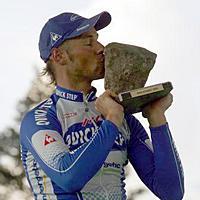
Recently on Cyclingnews.com |
104th Paris-Roubaix - PT
France, April 9, 2006
WWIII: La Trouée d'Arenberg is back
By Anthony Tan

|
Dating back to its first use in 1968 and with a history of creating the first decisive split in this race of epic proportions, the return of the 2,400 metre-long section of pavé, otherwise known as the La Trouée d'Arenberg (The Trench of Arenberg), will bring the riders back to the front line of war as they tackle the 104th edition of Paris-Roubaix.
L'Enfer du Nord, or more commonly known as 'The Hell of the North', does in fact receive its name from a wartime era almost a century ago when the race was first run. And just like this year's edition will, the parcours of earlier Paris-Roubaix races followed many of the front lines used in the First World War, passing through the path of destruction created during four years of bloodied battle.
Under a joint initiative between race organiser A.S.O. (Amaury Sport Organisation) and the Conseil Général du Nord of the Community of agglomeration of the Porte du Hainaut (and almost a month's work), the Trouée d'Arenberg has now been restored, damaged during the past few years due to a water run-off problem. Coming after 163,5 kilometres, by the time riders leave La Forêt d'Arenberg, there will be just under 100 kilometres left to race.
"It is now possible to guarantee to the cycling teams that the riders will not go through a trap when entering the Arenberg forest," said race director Jean-François Pescheux upon inspection in late February. "But be careful: the improvements brought to the Trouée do not mean that it'll be a boulevard - Arenberg remains one of the tricky portions of the race; it will still be important to leave it in the leading group to hope and win the race on the Roubaix velodrome."
Indeed, after the organisers' inspection of the parcours on Monday (see route details), Pescheux and his team have bestowed the highest (or worst, depending on whether you're riding or watching) rating to La Trouée d'Arenberg - five out of five stars.
Last year, 'the Spanish Flandrien', Juan Antonio Flecha, the always consistent George Hincapie and the new king of Belgian cycling, Tom Boonen, arrived on the banks of this aforementioned velodrome as one. With one lap remaining, Boonen was perfectly positioned in third wheel, nervous though confident in his abilities after his first Ronde van Vlaanderen victory a week before; #71, the quiet American George Hincapie, was the piggy in the middle, unsure whether to look ahead or behind him; and Flecha - the slowest of the three on paper - probably required a change of shorts at that point.
The Spaniard jumped with 250 metres to go, but as Boonen flew down the banking like a pure track sprinter, the audience knew there could be only one winner...
One year older and looking as strong as ever after a relatively easy repeat victory in De Ronde last Sunday, 25 year-old Boonen will enter the 2006 edition of Paris-Roubaix as the outright favourite. Eleven victories so far this season, the world champion has made a mockery of the 'curse of the rainbow jersey' and can seemingly do no wrong. Yet unlike the Ronde, or any other race for that matter, there is a larger than normal degree of luck in 'The Hell of the North'.
Yes, in 259 kilometres that includes 52,7 kilometres of pavé broken into 27 secteurs (with reverse numbering used), this fascinating race, 'celebrated' on the second Sunday in April every year, can sometimes be a lottery. However, as former Tour de France director Jean-Marie Leblanc said: "Paris-Roubaix is hence not a grand cycling race like certain others and yet it is a finer race than many, in terms of its extraordinary dimension and the values it demands, which at times seem to call upon past values: tenacity, daring, heroism. Is this such a paradox if we acknowledge that the tough and the fine can exist harmoniously together?"
One can mitigate risk through choice of equipment (something Cyclingnews will detail in a special Tech report before and after the race); a solid team - Quick.Step, Davitamon-Lotto and before Roger Hammond's crash in Flanders, Discovery were the strongest teams on paper, with T-Mobile, Team CSC, Crédit Agricole and Rabobank second - and experienced personnel; always staying up front, particularly before Arenberg; and of course, something that comes only with experience, mastering the pavé.
But who can beat Boonen, or at the very least, challenge him and the formidable Quick.Step team?
Davitamon-Lotto has Mattan, Van Bon and Van Petegem. Discovery now has Devolder, Hincapie, Hoste and Van Heeswijk. T-Mobile has Klier, Pollack and Wesemann. CSC has Cancellara and Michaelsen. Crédit Agricole has Bodrogi and Hushovd. Rabobank has Flecha and Hayman. Liquigas has Backstedt.
The rest? Place a few outside bets with Frank Hoj (Gerolsteiner), Baden Cooke (Unibet.com), Francisco Ventoso (Saunier Duval-Prodir), Bernhard Eisel and Frédéric Guesdon (Française des Jeux) and Aart Vierhouten (Skil-Shimano).
Tech special
As mentioned earlier, Cyclingnews will be previewing the equipment to be used by the contenders - including everything from frames to components to wheels - then later reviewing how it fared in the hardest bike race on the planet.
Live coverage
Cyclingnews will be covering the 104th Paris-Roubaix live, beginning at 10:30 local time (CEST)/04:30 EDT (USA East)/01:30 PDT (USA West)/19:30 AEST (Australia East).
